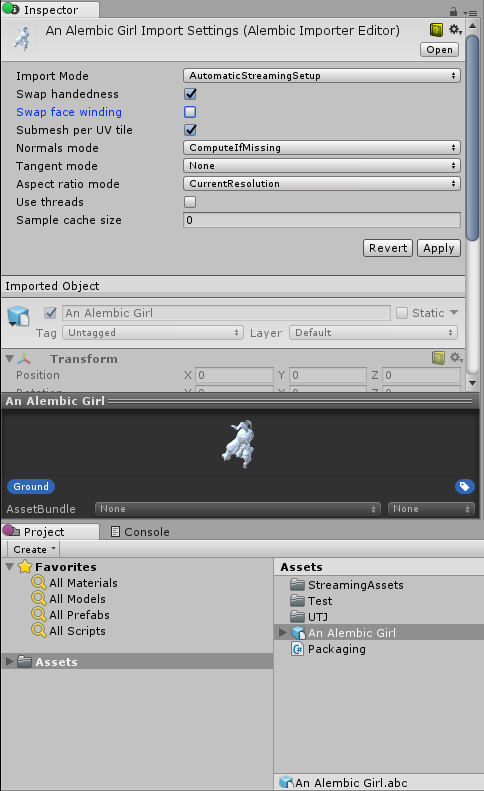Scripted Importers
Scripted Importers are part of the Unity Scripting API. Use Scripted Importers to write custom Asset importers in C# for file formats not natively supported by Unity.
Create a custom importer by specializing the abstract class ScriptedImporter and applying the ScriptedImporter attribute. This registers your custom importer to handle one or more file extensions. When a file matching the registered file extensions is detected by the Asset pipeline as being new or changed, Unity invokes the method OnImportAsset of your custom importer.
Note: Scripted Importers cannot handle a file extension that is already natively handled by Unity.
Note: Limitation
This is an experimental release of the Scripted Importer feature and as such is limited to assets that can be created using the Unity Scripting API. This is not a limitation of the implementation or design of the this feature, but does impose limits on its real-world use.
Example
Below is a simple example as Scripted Importer: It imports asset files with the extension “cube” into a Unity Prefab with a cube primitive as the main Asset and a default material with a color fetched from the Asset file:
using System.IO;
using System.Text;
using UnityEditor.Experimental.AssetImporters;
using UnityEngine;
[ScriptedImporter(1, "cube")]
public class CubeImporter : ScriptedImporter
{
[SerializeField]
float m_ColorShift = 0f;
public override void OnImportAsset(AssetImportContext ctx)
{
// Main asset
var cube = GameObject.CreatePrimitive(PrimitiveType.Cube);
ctx.SetMainAsset("MainAsset", cube);
// Material as sub-asset
string text = File.ReadAllText(ctx.assetPath, Encoding.UTF8);
var channels = text.Split(',');
var color = new Color(float.Parse(channels[0]) + m_ColorShift,
float.Parse(channels[1]) + m_ColorShift,
float.Parse(channels[2]) + m_ColorShift);
var material = new Material(Shader.Find("Standard")) { color = color };
cube.GetComponent<Renderer>().material = material;
ctx.AddSubAsset("Material", material);
}
}
Note:
- The importer is registered with Unity’s Asset pipeline by placing the the
ScriptedImporterattribute on the CubeImporter class. - The CubeImporter class implements the abstract
ScriptedImporterbase class. -
OnImportAsset’s ctx argument contains both input and output data for the import event. - Each import event must generate one (and only one) call to
SetMainAsset. - Each import event may generate as many calls to
AddSubAssetas necessary. - Please refer to the Scripting API documentation for more details.
You may also implement a custom Import Settings Editor by specializing ScriptedImporterEditor class and decorating it with the class attribute CustomEditor to tell it what type of importer it is used for.
For example:
using UnityEditor;
using UnityEditor.Experimental.AssetImporters;
using UnityEditor.SceneManagement;
using UnityEngine;
[CustomEditor(typeof(CubeImporter))]
public class CubeImporterEditor: ScriptedImporterEditor
{
public override void OnInspectorGUI()
{
var colorShift = new GUIContent("Color Shift");
var prop = serializedObject.FindProperty("m_ColorShift");
EditorGUILayout.PropertyField(prop, colorShift);
base.ApplyRevertGUI();
}
}
Using a Scripted Importer
Once you have added a scripted importer class to a project, you may use it just like any other native file type supported by Unity:
- Drop a supported file in the Asset directory hierarchy to import.
- Restarting the Unity Editor reimports any files that have changed since last update.
- Editing the Asset file on disk and returning to the Unity Editor triggers a reimport.
- Import a new asset using Asset > Import New Asset….
- Explicitly trigger a re-import via the menu: Asset > Reimport.
- Click on the Asset to see its settings in the Inspector window. To modify its settings, edit them in the Inspector window and click Apply .

Real-world use of Scripted Importers
Alembic: The Alembic importer plug-in has been updated to use a Scripted Importer. For more information, visit Unity github: AlembicImporter.
USD: The USD importer plug-in has been updated to use a Scripted Importer. For more information, please visit Unity github:: USDForUnity.
New feature in 2017.1 NewIn20171
2017–07–27 Page amended with no editorial review